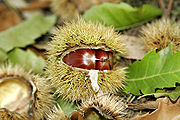
Cupule
Encyclopedia

Accessory fruit
An accessory fruit is a fruit in which some of the flesh is derived not from the ovary but from some adjacent tissue exterior to the carpel. Examples of accessory tissue are the receptacle of strawberries, figs, or mulberries, and the calyx of Gaultheria procumbens or Syzygium jambos...
of flowering plant
Flowering plant
The flowering plants , also known as Angiospermae or Magnoliophyta, are the most diverse group of land plants. Angiosperms are seed-producing plants like the gymnosperms and can be distinguished from the gymnosperms by a series of synapomorphies...
s in the family Fagaceae
Fagaceae
The family Fagaceae, or beech family, comprises about 900 species of both evergreen and deciduous trees and shrubs, which are characterized by alternate simple leaves with pinnate venation, unisexual flowers in the form of catkins, and fruit in the form of cup-like nuts. Fagaceous leaves are often...
. These two parts derive from different flower components.
The cupule holds and protects the seed
Seed
A seed is a small embryonic plant enclosed in a covering called the seed coat, usually with some stored food. It is the product of the ripened ovule of gymnosperm and angiosperm plants which occurs after fertilization and some growth within the mother plant...
during its growth and maturation. In some genera (e.g. Lithocarpus
Lithocarpus
Lithocarpus is a genus in the beech family Fagaceae, differing from Quercus in the erect male spikes. The World Checklist accepts 334 species, though some other texts suggest as few as 100 species. About 100 Asian species of the genus were formerly treated in the genus Pasania. All but one are...
, Quercus
Oak
An oak is a tree or shrub in the genus Quercus , of which about 600 species exist. "Oak" may also appear in the names of species in related genera, notably Lithocarpus...
), it only partly encloses the single nut, while in others (e.g. Castanea
Chestnut
Chestnut , some species called chinkapin or chinquapin, is a genus of eight or nine species of deciduous trees and shrubs in the beech family Fagaceae, native to temperate regions of the Northern Hemisphere. The name also refers to the edible nuts they produce.-Species:The chestnut belongs to the...
, Fagus
Beech
Beech is a genus of ten species of deciduous trees in the family Fagaceae, native to temperate Europe, Asia and North America.-Habit:...
), it fully encloses the two or more nuts, and splits open at maturity into four valves to release the nuts. It is derived from the vegetative part of the flower (its attachment to the rest of the plant).
The cupule is covered by numerous scales. In some (e.g. Castanea), the scales are developed into sharp spines, giving the nut protection from squirrel
Squirrel
Squirrels belong to a large family of small or medium-sized rodents called the Sciuridae. The family includes tree squirrels, ground squirrels, chipmunks, marmots , flying squirrels, and prairie dogs. Squirrels are indigenous to the Americas, Eurasia, and Africa and have been introduced to Australia...
s and other seed predators, while in others (e.g. most Quercus), they are not. In Lithocarpus, the cupule is very hard and bone-like in texture.
The calybium (plural: calybia) is the fruit proper. It develops from an inferior ovary, meaning it is initially encased in the future cupule. Technically the calybium is a nut
Nut (fruit)
A nut is a hard-shelled fruit of some plants having an indehiscent seed. While a wide variety of dried seeds and fruits are called nuts in English, only a certain number of them are considered by biologists to be true nuts...
, as its ovary wall becomes dry with the embryo loosely enclosed inside, and remains closed until germination
Germination
Germination is the process in which a plant or fungus emerges from a seed or spore, respectively, and begins growth. The most common example of germination is the sprouting of a seedling from a seed of an angiosperm or gymnosperm. However the growth of a sporeling from a spore, for example the...
.
In the related family Betulaceae
Betulaceae
Betulaceae, or the Birch Family, includes six genera of deciduous nut-bearing trees and shrubs, including the birches, alders, hazels, hornbeams and hop-hornbeams, numbering about 130 species...
, notably in the genera Carpinus
Hornbeam
Hornbeams are relatively small hardwood trees in the genus Carpinus . Though some botanists grouped them with the hazels and hop-hornbeams in a segregate family, Corylaceae, modern botanists place the hornbeams in the birch subfamily Coryloideae...
and Corylus
Hazel
The hazels are a genus of deciduous trees and large shrubs native to the temperate northern hemisphere. The genus is usually placed in the birch family Betulaceae, though some botanists split the hazels into a separate family Corylaceae.They have simple, rounded leaves with double-serrate margins...
, the cupule is replaced by an involucre, which differs in being more leafy in appearance, but performs a similar role in protecting the developing nuts.

